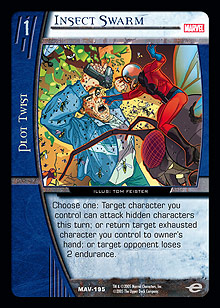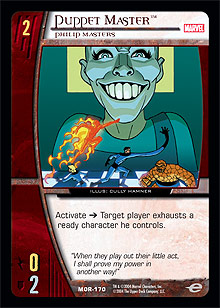
I’m a huge sucker for cards that do multiple things. I not only respect the power of cards that provide multiple options, but also find that the conundrums that come with such options are some of the game’s most entertaining and challenging. (Do I use this card now to accomplish X? Or do I hang onto it, since doing Y will be important later?)
Insect Swarm does just that, providing not two but three completely different effects. None of them are particularly amazing on their own, and there are specialized cards that mirror each, but it’s the versatility of the card that makes it noteworthy.
 Insect Swarm is essentially the mutated lovechild of No Man Escapes the Manhunters, Swift Escape, and Surprise Attack. It techs hidden characters, returns characters to your hand, and dishes out direct burn. What it doesn’t do is give you No Man’s combat advantage, work on readied characters like Escape, or inflict as much damage as Surprise Attack. You’re literally trading specialization and focused efficiency for flexibility.
Insect Swarm is essentially the mutated lovechild of No Man Escapes the Manhunters, Swift Escape, and Surprise Attack. It techs hidden characters, returns characters to your hand, and dishes out direct burn. What it doesn’t do is give you No Man’s combat advantage, work on readied characters like Escape, or inflict as much damage as Surprise Attack. You’re literally trading specialization and focused efficiency for flexibility.
The best way to get the long end of the stick on any deal like this is to find ways to compensate for the tradeoffs you’re making. Ideally, you’ll get more efficiency than was intended from the limited effects of Insect Swarm while still enjoying its variety of uses. This is completely dependant on where and how you use each effect, so let’s look at them one by one.
Target character you control can attack hidden characters this turn:
In essence, anything that is designed to penalize the use of hidden characters and the concealed mechanic runs the risk of being narrow. While many players make use of the stealthy options available, some teams flat out don’t have any, and some strategies just don’t jive with the entire hidden concept.
R&D can’t just make effects that brutally punish the use of the hidden area. Not only would such cards have potentially unfair synergy with things that force opposing characters into hiding (like Dr. Strange and Krona), but also there’s little point in creating a new keyword and then allowing players to smite it with a single card. Design is in a situation where they want to create an effect that disrupts hidden characters, but they are faced with a problem in doing so—creating a focused card makes it narrow and useless in some matchups, and compensating for this with more power ends up creating a dangerous imbalance.
The solution is to add more utility to cards that beat up on hidden characters, and this is accomplished by adding extra functionality. Within that view, the fact that Insect Swarm doesn’t give -3 to DEF (like No Man Escapes the Manhunters does) is virtually irrelevant; it’s all a matter of utility and what suits your needs. No Man gets its utility from its combat modifier, and thus can be useful regardless of the matchup in which it’s being played. Swarm does the same thing by having two additional effects. On some levels, both cards accomplish the same thing.
In Tier 1 Constructed play, hidden characters are easily found in Curve Sentinels (Hounds of Ahab) and Common Enemy (Valeria Richards) and are working their way into other decks. Karl-Heinz Bergt’s Dark Knights deck that won him $10K Munich is bound to see imitation over coming months, and both the Avengers and Kang Council have concealed characters that range from pestering to deadly.
In Sealed Pack formats, the ability to attack hidden characters will be most important when competing against the two aforementioned teams. Kang, Master of Time can be especially bothersome because he’s a common and acts as a walking card drawing engine. He can quickly allow an opponent to outpace you in a format where card advantage is king, and he’s just one of the format’s effect-generating characters that Swarm can allow you to disrupt.
Return target exhausted character you control to its owner’s hand:
Bumping a character back to your hand accomplishes two primary goals. First, it can remove a character from the line of fire, either making up for a weakness in your formation (scooping up an isolated character without reinforcement, for instance) or costing an opponent whatever one-shot effects he or she committed to the attack. Second, it permits the re-recruitment of characters you’d like to use multiple times due to an activated or triggered effect that goes off when the character comes into play.
 The restriction of only being able to bounce exhausted characters can be worked around. In the case of an activated effect that you’d like to reuse, the character will be exhausted anyway. Puppet Master loves it. On the other hand, while it’s far less useful in combat than Swift Escape if you didn’t control the initiative, it loses virtually nothing when you do have the initiative and go all-out to take down multiple characters. Some decks, like TNB and Titans, can attack back against an exhausted board and give an attacker of any size massive pumps. The natural inclination there is usually to go for a smaller character in order to push through as much breakthrough as possible. This works perfectly in the case of the defending Insect Swarm player, as that small character returning to the hand represents a relatively small loss of resource points and can save you from taking significant amounts of damage. While System Failure can also succeed in nixing an opponent’s overaggressive attacks, it doesn’t have the synergistic potential with certain character effects that bounce has.
The restriction of only being able to bounce exhausted characters can be worked around. In the case of an activated effect that you’d like to reuse, the character will be exhausted anyway. Puppet Master loves it. On the other hand, while it’s far less useful in combat than Swift Escape if you didn’t control the initiative, it loses virtually nothing when you do have the initiative and go all-out to take down multiple characters. Some decks, like TNB and Titans, can attack back against an exhausted board and give an attacker of any size massive pumps. The natural inclination there is usually to go for a smaller character in order to push through as much breakthrough as possible. This works perfectly in the case of the defending Insect Swarm player, as that small character returning to the hand represents a relatively small loss of resource points and can save you from taking significant amounts of damage. While System Failure can also succeed in nixing an opponent’s overaggressive attacks, it doesn’t have the synergistic potential with certain character effects that bounce has.
Target opponent loses 2 endurance:
While 2 endurance isn’t a massive blow, it’s better than nothing, and that’s really how you need to think of it in the context of Insect Swarm. You have two effects that are powerful but conditional, and while each can be useful, you’ll sometimes draw into Insect Swarm and find that both are of little use. If Insect Swarm only had its first two effects, it would be a dead card in such situations. Its ability to dish out 2 endurance loss ensures that it will maintain a certain level of usefulness no matter what, and that makes it incredibly playable.
In addition, while 2 endurance loss might not seem like much when you hold it up to Surprise Attack’s 5, it’s important to remember that Surprise Attack will often just dish out 3 damage, anyway. Games certainly have been won or lost over 2 endurance, and having the ability to chuck a card you don’t need to tip the scales is really pretty powerful.
So, where can Insect Swarm see play? Probably not in anything Tier 1 in the near future. X-Stall can make really good use of it, though, bouncing Puppet Masters for reuse while capitalizing on the endurance disparities from which it often wins when games go to time.
It’s interesting in swarm decks running a split between low cost and medium cost characters because of what it can do to protect disrupted formations. While Flame Trap, Reign of Terror, and even just good ol’ overextension can leave characters in swarm strategies isolated, Insect Swarm’s ability to defeat one-shot combat pumps can be invaluable if you can afford to bump characters. A Golden Age Manhunter swarm deck might find this card interesting. It can be used on defense to minimize artificially enlarged offensives, but it can also allow attack-based field control by exposing hidden characters to your horde, which fits the Manhunter’s control style.
All in all, Insect Swarm is a versatile little bag of tricks wrapped up in a single blue border. It’s interesting not just for its play potential, but also for the ways in which it interacts with concepts of utility within the Vs. System. The idea of conditional cards being balanced with extra effects is one that is bound to see growth in the future. In the mean time, Insect Swarm provides some clever options for the right decks!